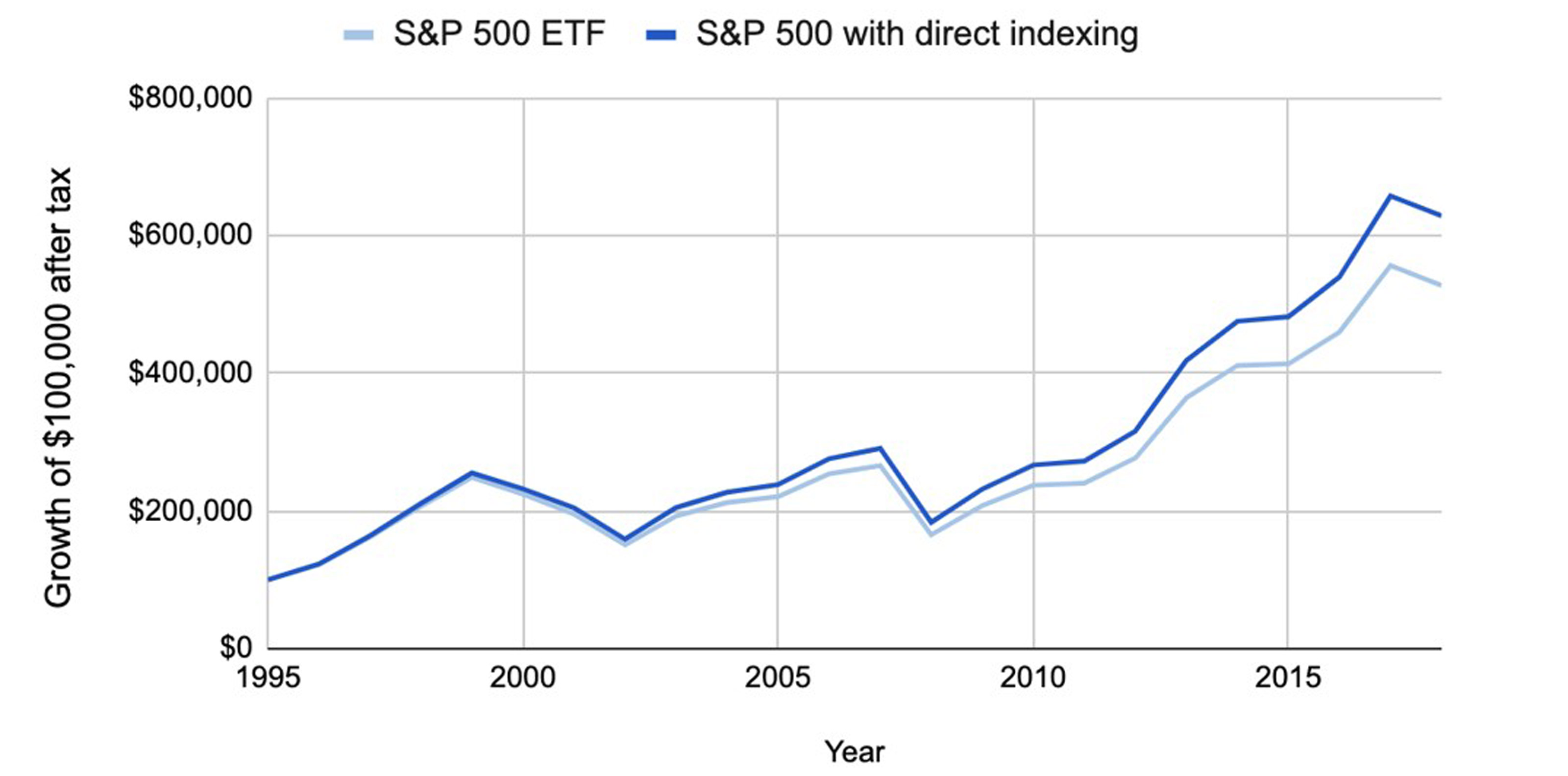Move Over ETFs: Direct Indexing Is an Investment Strategy Worth Paying Attention to
More flexibility, more control, the potential for higher returns and tax-reducing strategies: With pros like that, could direct indexing be right for you?


Recently, direct indexing, a lesser-known investment approach, has started outpacing both ETFs and mutual funds in investor adoption. Direct indexing offers unique benefits that can’t be replicated in a traditional ETF or mutual fund structure, particularly around personalization and tax management.
Given its benefits, direct indexing is expected to continue to outpace ETF and mutual fund growth over the coming years according to a recent Cerulli report. Here’s what you need to know about this growing investment method.
What is direct indexing?
Direct indexing is an investment strategy where an investor holds individual stocks that make up an index in their own account directly, instead of using a mutual fund or ETF to track the underlying index. Similar to an index fund, the goal is to track the performance of a target benchmark index. However, when an investor holds the individual securities directly in their account, it allows for more personalization and the potential for greater tax benefits.

Sign up for Kiplinger’s Free E-Newsletters
Profit and prosper with the best of expert advice on investing, taxes, retirement, personal finance and more - straight to your e-mail.
Profit and prosper with the best of expert advice - straight to your e-mail.
Direct indexing has been the core of many high-net-worth clients’ strategies for decades. It’s no surprise, given its unique benefits, particularly around taxes. Offered mostly through financial advisers, investment minimums for direct indexing are often $250,000 or more. However, no-commission trading and fractional shares have made the strategy more broadly accessible, with minimums at or below $5,000 in some cases.
A lower tax bill
With hundreds of individual stocks held in a direct indexing portfolio, there are extensive opportunities for tax loss harvesting – the practice of selling a security at a loss to offset capital gains. Even in up markets, individual stocks can have bouts of poor performance. Direct indexing portfolios can take full advantage, harvesting losses in underperforming stocks even as the market as a whole is up. This can mean 1% or more in additional after-tax returns, according to recent research from Vanguard.
A separate study looked at historical returns over the last century and found that direct indexing added 1.08% annually in after-tax returns. From 1995 to 2018, the most recent period studied, an investor using a direct indexing strategy to track the S&P 500 would have seen their $100,000 initial investment grow to about $630,000 after accounting for taxes. That’s $101,000 more than they otherwise would have had.
Note: The dark blue line in the graph represents the after-tax value of a portfolio that tracks the S&P 500 using direct indexing and employs a tax loss harvesting strategy. By comparison, the light blue line represents the after-tax value of an ETF that tracks the S&P 500.

Sources: Chaudhuri, Burnham, Lo 2020; author’s calculations.
The flexibility of direct indexing also allows for portfolios to be built around existing holdings. This becomes particularly important when a portfolio has embedded gains in concentrated positions. In such a case, an investor can diversify around existing positions while managing any potential tax impact from liquidating positions.
Pinpoint personalization
By holding securities in their own accounts, investors are free to customize portfolios as they see fit. Such customization is not possible in a fund, as each investor has exposure to the same set underlying securities as every other shareholder.
Direct indexing portfolios can tilt toward ESG factors, or exclude securities that do not align with an investor’s values. Because this can be done at the individual account level, investors don’t need to compromise on their values when building their portfolio. Additionally, holding individual stocks allows shareholders to participate directly in proxy voting, another source of control for investors.
Personalization affords another important benefit: better behavior. It’s often easier to not overreact in a down market and stick to a savings plan when your investments reflect your values.
Too much personalization, however, can cause direct index performance to deviate – positively or negatively – from the target index. Every investor has their own tolerance for risk and performance, and investors should be aware that there is a tradeoff between customization and tracking the benchmark index.
Is direct indexing right for me?
One of the main advantages of direct indexing is that it can generate additional capital losses. Capital losses are most useful when an investor has capital gains to offset from other investments. For investors with little or no outside capital gains, the tax benefits afforded are more limited.
Additionally, direct indexing has more moving parts than a portfolio that uses funds. Holding individual securities and trading them for tax loss harvesting means more transactions to account for at tax time.
For many, direct indexing will be the future of investing
Direct indexing strategies are growing faster than other investment vehicles. And for good reason, the strategy offers benefits that are difficult or impossible to replicate using a fund. Recent innovations, like fractional share trading, have lowered the barrier to entry to direct indexing portfolios.
A once rarified investment strategy is now poised for broader adoption and with it the potential to generate better outcomes for many investors.
Get Kiplinger Today newsletter — free
Profit and prosper with the best of Kiplinger's advice on investing, taxes, retirement, personal finance and much more. Delivered daily. Enter your email in the box and click Sign Me Up.

Adam Grealish serves as Head of Investments at Altruist, a fintech company on a mission to make great independent financial advice more affordable and accessible. With a career rooted in financial innovation, Adam most recently led Betterment's strategic asset allocation, fund selection, automated portfolio management, and tax strategies. In addition, he served as a vice president at Goldman Sachs, overseeing the structured corporate credit and macro credit trading strategies.
-
 Fired Up By the Masters and RBC Heritage? See These Homes for Sale By Golf Courses
Fired Up By the Masters and RBC Heritage? See These Homes for Sale By Golf CoursesFive homes for sale near golf courses, for people who can't get enough of the tour.
By Alexandra Svokos
-
 The Economic Impact of the US-China Trade War
The Economic Impact of the US-China Trade WarThe Letter The US-China trade war will impact US consumers and business. The decoupling process could be messy.
By David Payne
-
 Will My Children Inherit Too Much?
Will My Children Inherit Too Much?If you worry about how your children will handle an inheritance, you're not alone. Luckily, you have options — from lifetime gifting to trusts — that can help.
By Mallon FitzPatrick, CFP®, AEP®, CLU®
-
 Charitable Giving Lessons From Netflix's 'Apple Cider Vinegar'
Charitable Giving Lessons From Netflix's 'Apple Cider Vinegar'Charity fraud is rife, and a Netflix series provides a timely warning about donating money to a good cause without looking into its background.
By Peter J. Klein, CFA®, CAP®, CSRIC®, CRPS®
-
 Four Takeaways From Filing Your Taxes to Boost Your Financial Future
Four Takeaways From Filing Your Taxes to Boost Your Financial FutureNow that another tax season is in the rearview mirror for most of us, what lessons can you take from what you learned about your finances to plan for the future?
By Kate Winget
-
 What Claims Adjusters Are Thinking vs What They're Saying
What Claims Adjusters Are Thinking vs What They're SayingAfter a natural disaster, few of us are at our best, but here's what to keep in mind when you're interacting with your insurance company's claims adjuster.
By Karl Susman, CPCU, LUTCF, CIC, CSFP, CFS, CPIA, AAI-M, PLCS
-
 Looking to Make a Job Change? How to Stand Out Like a Pro
Looking to Make a Job Change? How to Stand Out Like a ProTo make a strong first impression in interviews or when networking, skip your job title and work history and use an opening gambit that highlights your talents.
By Anne deBruin Sample, CEO
-
 Stock Market Today: No 'Powell Put'? No Problem
Stock Market Today: No 'Powell Put'? No ProblemInvestors, traders and speculators look beyond both another Trump post and more signs of slowing economic activity.
By David Dittman
-
 First 100 Days: Trump's Impact on Your Finances
First 100 Days: Trump's Impact on Your FinancesHere are some opportunities to consider regarding investing, interest rates and tax cuts as the financial landscape shifts under the new administration.
By Daniel Razvi, Esquire
-
 What Would Happen if You Put Your Tax Refund in an IRA?
What Would Happen if You Put Your Tax Refund in an IRA?Not only could you get a tax break, but the compounding effect over 35 years could turn the average refund into nearly $14,000.
By Romi Savova